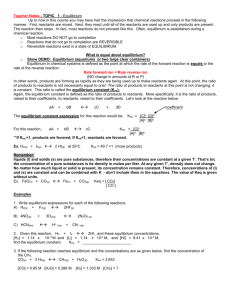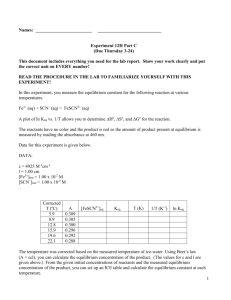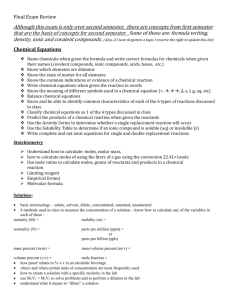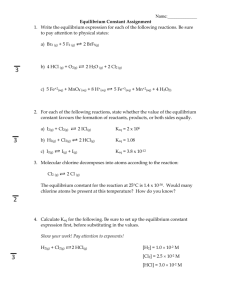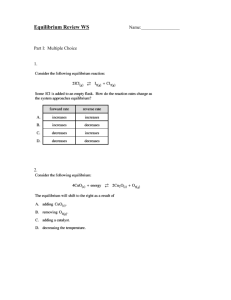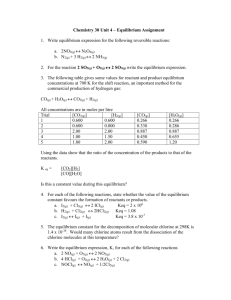EquilibriumNotesOver..
advertisement
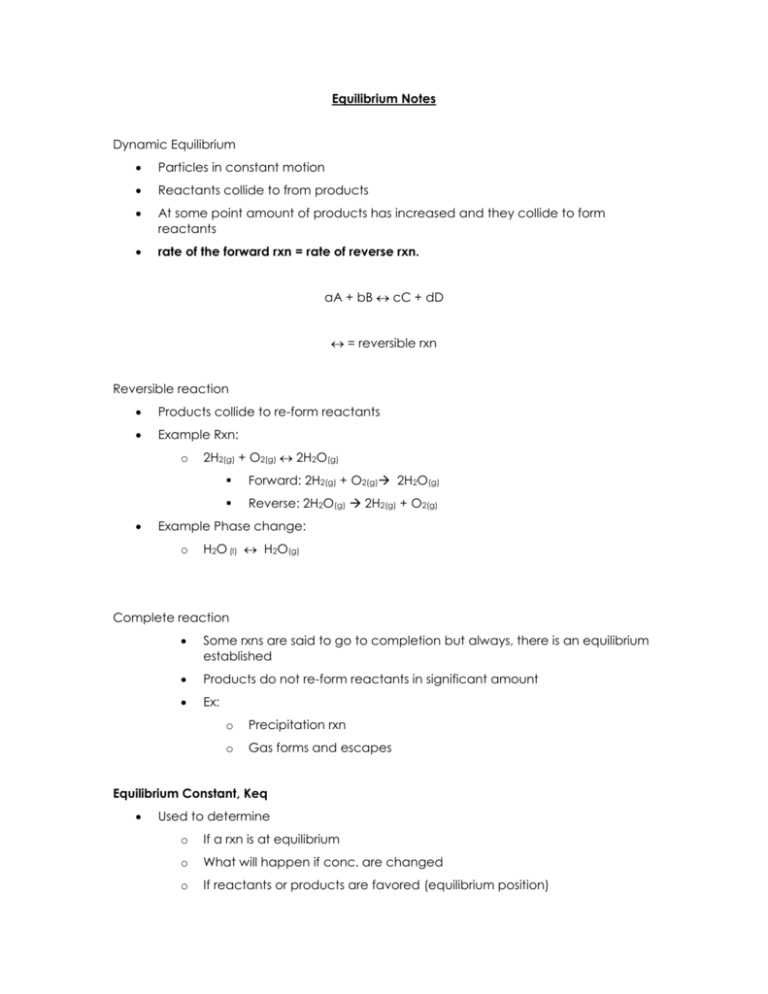
Equilibrium Notes Dynamic Equilibrium Particles in constant motion Reactants collide to from products At some point amount of products has increased and they collide to form reactants rate of the forward rxn = rate of reverse rxn. aA + bB cC + dD = reversible rxn Reversible reaction Products collide to re-form reactants Example Rxn: o 2H2(g) + O2(g) 2H2O(g) Forward: 2H2(g) + O2(g) 2H2O(g) Reverse: 2H2O(g) 2H2(g) + O2(g) Example Phase change: o H2O (l) H2O(g) Complete reaction Some rxns are said to go to completion but always, there is an equilibrium established Products do not re-form reactants in significant amount Ex: o Precipitation rxn o Gas forms and escapes Equilibrium Constant, Keq Used to determine o If a rxn is at equilibrium o What will happen if conc. are changed o If reactants or products are favored (equilibrium position) If Keq >> 1, products favored If Keq << 1, reactants favored If Keq = 1, than neither side favored If Keq between 10-2 and 102, both reactant and product will be present in significant amt. Symbol = Keq o Kc (for rxns in sol’n, c = conc.) o Kp (for gas rxns, p = pressure) o Ka (for acid dissociation rxn) o Kw (for water dissociation) o NaOH(s) Na+(aq) + OH-(aq) Ksp (for solubility) 2 H2O H3O+1 + OH-1 Kb (for base dissociation rxn) o HCl(s) H+(aq) + Cl-(aq) NaCl(s) Na+(aq) + Cl-(aq) What affects Keq ? Factor Affects Keq? Temperature Yes Starting concentration No Catalysts No Pressure No How to write equilibrium expressions: Given the following reaction aA + bB cC + dD [C ]c [ D]d Keq [ A]a [ B]b Given the following reaction: 2H2O(g) 2H2(g) + O2(g) [ H 2 ]2 [O2 ] Keq [ H 2O]2 Homogeneous Equilibrium: products and reactants are all in same phase Heterogeneous Equilibrium: products and reactants are in different phases o Ex: AgNO3 + NaCl AgCl (s) + NaNO3(aq) Pure solids and liquids are not included in equilibrium expressions [ NaNO3 ] Keq [ AgNO3 ][ NaCl ] Given the concentrations of reactants and products at equilibrium, you can put them into the equation above and calculate the same number – this is what makes it a constant. Example: (Example 1) Concentration of substance after equilibrium is reached (Example 2) Concentration of substance after equilibrium is reached [H2] 10 M, 20 M [O2] 5M 1.25 M [H2O] 2M 2M Keq Keq 102 5 =125 22 Keq This example is showing that even when the concentrations at equilibrium have changed (because starting amounts were changed), the value of Keq is the same 202 1.25 =125 22 You can also use Keq to find out of a reaction is at equilibrium Lets say that you start a reaction by mixing H2 and I2 gas. You need to know when the reaction has reached equilibrium so you periodically measure the concentration of H2, I2, and HI that are present After 1 minute the concentrations are as follows [H2] 8 M, [O2] 4M [H2O] 1M Keq Keq 82 4 =256 12 o The reaction is not at equilibrium yet because the concentrations do not show an equilibrium constant of 125. o The reaction will proceed in a direction that increases the amount of products (forward direction) Le Chatelier’s principle A reaction at equilibrium will proceed in a direction that relieves the stress put upon it. Possible stresses: o Temperature o Volume o Pressure o Concentration Example: 2H2(g) + O2(g) + energy 2H2O(g) If [H2] increases, o If [H2] is decreased o Because energy is a reactant, reaction will proceed to left to make up some of the energy that was lost When pressure is increased (or Volume decreased) o Because energy is a reactant, reaction will proceed to right to use up the added energy If temperature is decreased o Reaction will proceed to left to make up some of the H2 that was lost If temperature is increased, o reaction will proceed to right to produce more product and used up the excess [H2] Reaction will proceed to make fewer moles of gas, will shift to right When pressure in decreased (or Volume increased) o Reaction will proceed to make more moles of gas, will shift to left


